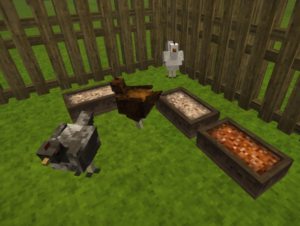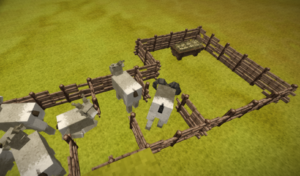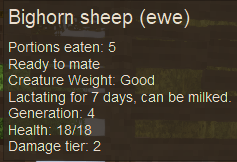Животноводство
Vintage story имеет в себе несколько механик, позволяющих одомашнивать некоторых животных, бродящих по миру вокруг. Для одомашнивания игрок должен поймать хотя бы одного самца и одну самку для их последующего спаривания в загоне. После некоторых поколений поведение животных изменится. Но даже после одомашнивания, кабаны и большерогие овцы будут атаковать вас, если их ударить.
Generational changes
Only the mothers heritage matters, the father is not considered when checking for the newborns generation. This means, if you have a female gen3 and a male gen4, the babies will always be gen4, as the child will always be one generation up from the mother.
- After 3 generations:
- Animals can be
killed nearly instantly with the cleaver.
- After 10 generations:
- Sleeping Animals will no longer wake when a player approaches .
- Aggressive animals will become neutral, i.e. only attack when being provoked.
- Animals will no longer run away from the player.
For testing purposes, in version 1.14 there is a command which the player can use to change the generation of livestock:
/debug setgen [number] - with number being the generation the player wants the animal to be
Moving Animals
As of version 1.4, the game does not have leashes or similar means to easily transport animals, either for capturing wild ones, or moving already domesticated ones.
Capturing Wild Animals
For capturing wild animals, two different methods can be employed:
- Active: Provoke the wild boars/pigs or bighorn sheep with a weak attack. In return, boars and sheep will try to attack players. If players run away from them, they will follow for a short distance. This behavior can be used to guide them into carefully prepared animal pens. Female pigs and sheep will always follow their male counterpart. If you encounter a group of animals together, try only antagonizing the males - the females will automatically follow. Wild chickens always try to flee from the player, again, use this advantage by chasing the chickens into the pen.
- Passive: In an area nearby the animals to capture, dig a pit at least 2 blocks deep and place a trough with food portions in it. Wait for the animals to fall into the pit trap, and convert the pit into the animal pen. Players can also chase wild chickens into this pit trap.
Moving Domesticated Animals
Moving animals around can be complicated after the player has already started breeding them, as animals will loose their fear of the player after generation 10, and might not easily run away or be provoked to attack and follow.
Therefore, as an alternative to the above mentioned methods, a funnelling technique can be employed to move animals or even separate them if need be, for instance to cull lower generations.
To archive this, the player needs at least one trough, plenty of fence and the appropriate food for the animals. Then simply build a corridor from the original enclosure to the next one (or an in between stop). Place a filled trough in the new enclosure, and open the corridor on both ends. Make sure you are in a good position to place fences in the corridor as need be.
The animals will start walking from the original enclosure towards the filled trough, and the player should have enough time and space to place fences to separate the animals from each other. Depending on where the trough is placed, the walking direction of the animals can be influenced to give the player even more opportunity to intervene and pull animals out of the herd.
Breeding
All animals must consume portions of feed in order to breed. Placing 8 dry grass or 2 grain into a trough players can feed animals. Both male and female animals must eat until they become saturated. The Block info HUD shows the level of saturation when a player looks at an animal. It will also show the creature weight, generation, whether an animal is ready to breed, to milking and if it may disappear due to darkness.
Pigs
Boars eat animal feed placed in a large trough. The Sows will need a satiety value of 10 before they are ready to mate. After a pregnancy of 25 ingame days, sows bear litters of multiple piglets (4-6) at a time, so be sure the pen is large enough to accommodate for a "pigsplosion", which may occur when breeding multiple females simultaneously. Piglets will need 158 hours to grow up, with a chance of 75% to be female and 25% to be male. Sows will have 6-11 days of "cooldown" time before they can breed again.
Note that boars (and sometimes sows) will attack players when in close range but will become passive after 10 generations.
Sheep
Sheep eat animal feed placed in a large trough. Troughs hold portions of dry grass or grains and sheep will consume either grass or grain. The Ewes will need a satiety value of 10 before they are willing to mate. After a pregnancy time of 20 days, ewes bear one lamb at a time, chances for male or female are 50/50. Lambs will take 336 hours to grow up, and the Ewes will need 4-11 days break before they are ready to breed again.
Note that male sheep (and sometimes the females) always attack players when in close range, but they will stop doing so after 10 generations of breeding.
Chickens
Chickens will only eat grain placed in small troughs. Hens need to reach a satiety of 6 before they are ready to mate. For now, baby chicks are not preceded by eggs - they appear like other baby animals. The pregnancy takes 9 days for the hen and there will be 1-2 chicks, with a "cooldown" of 6-9 days before the next pregnancy. The chicks will grow up after 168 hours, with a 90% chance for more hens and only a 10% chance for a new rooster.
Hens will lay eggs on the ground every 8-15 in-game days, which can be used in cooked foods but do not have any impact on breeding new chickens. Players should collect the eggs regularly, as they disappear within 2 days.
Harvesting and Butchering
Domesticated, or wild, animals can be killed and harvested for meat, raw hides, bones, and fat. Shift+right click with a knife in hand to harvest or butcher animals.
Milking
Ewes lactate for 21 days after giving birth. At the moment, sheep can only be milked if they are generation 2 or above. They will indicate lactating regardless of generation, but when the player tries to milk them on generation 0 or 1, the bucket will come up empty. When hovering over the ewe, the following tool tip will be displayed:
Lactating for _ days, can be milked.
Note that ewes cannot be milked every day, despite lactating. The second part of the above tool tip will only be shown if they are actually ready to be milked. In some cases, they might also get stressed out and thus not ready to be milked.
When ready to milk, the player can right click and hold on the ewe with a bucket in hand. The milk can either be drunken directly when taken from the bucket with a bowl, or used in a barrel to make Cheese.
Creature Weight and Darkness
Two parts of husbandry that may be confusing for new players are the creature weight and darkness mechanics.
Creature Weight
The Block info HUD shows a property called "Creature Weight" which can range from good, decent, low, and starving. A lower creature weight causes fewer items to be dropped when it is killed. This is an issue over winter, or in cold areas, as it can significantly reduce the yield of livestock. Keeping animals well-fed prevents their weight from decreasing.
Darkness
Many animals will disappear if they are in darkness for too long and players can see if animals will disappear by looking at the Block info HUD. Light sources like oil lamps or lanterns, as well as sunlight, can prevent animals from disappearing.
Other animals
Bees cannot be domesticated, but the art of Beekeeping can help them be put in a 'controlled environment' as to be able to harvest their produce without having to kill them all off.
Foxes, hares, hyenas, raccoons, wolves, drifters and locusts cannot be domesticated and will have to be trapped and/or hunted down in order to reap the fruits of their dead bodies.
Foxes, hares, hyenas, raccoons, and wolves can be hunted for their meat, fat, hides and bones. Hunting Drifters can provide you with flax, rusty gears and temporal gear. Locusts however, have no drops so they only provide a distraction to harvest.
| {{{title}}} | |
|---|---|


